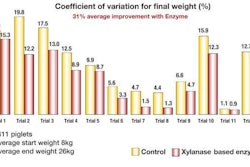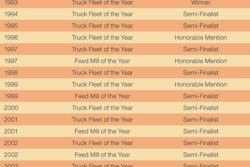Aquafeed and petfood manufacturers are using smarter and smarter tools to control the extrusion process. Upgrading from manual to fully automated process control of extrusion generates big savings in quicker start-up, less wasted product, and faster product changeovers. Automated systems can improve throughput as much as 40%, cut change-over times by more than 65%, and enhance product quality characteristics such as shape, consistency, palatability, etc.
Accurate management of delivery of the dry feed mash to the conditioner is the foundation for these performance improvements. An automated system controls virtually every input to the extrusion process--steam, water, fat, energy, main screw speed, etc.--as a proportion or in another direct relationship to the dry flow rate. Beyond control of feed flow rate, a variety of instrumentation and closed-loop controls downstream can fine-tune ingredient and moisture management during conditioning, extrusion, and drying.
For automated systems, we have found that the acceptable level of accuracy for dry feed flow is ±1% of maximum delivery rate, which requires metering by weight, typically by a loss-in-weight (LIW) method. By contrast, in most manual systems, feed mash delivery to the conditioner is on a volumetric basis with variation as much as ±6%. The volumetric systems, even if automated to some degree, struggle to accurately adjust for changes in material bulk density or flowability. Also, characteristics of the dry feed mix--grind and fat content, for example--have a significant effect on the metering characteristics of the mix.
The main challenge in managing the dry flow rate from the live bin or pre bin into the conditioner is the change in apparent bulk density' depending on the level of feed mash in the bin. If the live bin is 90% full, feed at the bottom has a much greater bulk density due to compaction than the same material when the bin is only 20% full. At 90% full, the discharge screw may operate at 17 rpm to move the same amount of material that is discharged at 20 rpm when the bin is 20% full.
Apparent bulk density is constantly changing with the filling and emptying of the live bin, which accounts for a large part of the inaccuracy in volumetric dry flow management. Volumetric dry flow control depends upon estimations of bulk density based on historical or empirical measurements. Instrumentation is available to accurately measure bulk density at the live bin discharge and thereby manage the dry flow rate, but it is expensive and there are simpler, more robust methods using the LIW technique.
Loss-in-weight systems, in which the live bin is mounted on load cells, are currently the industry standard for automated extrusion systems. The LIW systems continuously measure the weight of bin contents and maintain the flow rate at a given set point through a PID (proportional-integral-derivative control algorithm) which automatically modulates the discharge screw speed. The PID uses three constants--set point (SP), process variable (PC), and control variable (CV)as values in operating the closed control loop (see figure Closed-loop control').
There are different approaches to the dry flow PID algorithm. Typically, the approaches using higher-order math are more accurate. Some incorporate error feedback into the equation to improve accuracy, although the error data are estimations also, not based on actual or empirical measurement.
With any system, the delivery error should be less than ±1% in order to manage the moisture and other ingredient streams precisely. However, it has been our experience that traditional LIW techniques will not consistently produce acceptable accuracies. The challenge is greatest during live bin filling (see figure Dry mix feeder').
During live bin filling, LIW requires additional methods to maintain accuracy in the dry flow rate. In the empty bin condition, some systems 'lock-in' the previous feeder screw speed, which tends to over-compensate the flow. Others lock-in the screw speed at some percentage of the full-bin speed. Others make a straight-line' approximation based on screw speed at full and near-empty bin levels and adjust discharge rate along that line during the bin fill period.
This is a field of automated process control where there is considerable development. Neural nets, fuzzy logic, and adaptive modeling are the more popular 'intelligent' control schemes.
In our experience, adaptive modeling offers the most accurate and reliable technique to manage dry flow rate during bin filling. For this technique, we have developed a proprietary algorithm that accounts for the specific dry feed being processed and further determines how to manage the feed delivery system during the live-bin refill. This mathematical model continues to be refined during every cycle of active LIW mode to improve the mass flow management during the refill cycle.
The model uses data 'snap shots' of the bin full-to-empty cycle based on 150 data samples collected during actual operation. The system then 'learns' to control flow rate from batch to batch. In effect, the modeling replicates discharge conditions for that feed on that day and adjusts accordingly. During typical operations, the modeling is only one batch behind the feed being processed and easily makes necessary flow rate adjustments. In case of a drastic change-over of product type, the automatic adjustment may be less graceful, but adjusts appropriately in subsequent batches.
Overall, adaptive modeling of flow rate for bin filling periods significantly improves accuracy versus other techniques. However, in the case of very quick refills, on the order of less than 5 seconds, adaptive modeling may not generate greater accuracy than other techniques because the control loop does not have time to respond before the next cycle. But with bin fill periods greater than a few seconds, the system is learning and adjusting to keep flow rate within 1 percent variability.
Besides being quick to adjust to system process changes, the adaptive modeling technique is also relatively independent of the system hardware configuration. This means that software modification is not necessary whenever any hardware is changed.
Once a predictable dry feed delivery system is in place, then the other ingredient streams can be accurately managed by slaving them to the dry feed rate on a ratio basis. The other feed parameters, such as moisture addition and alternate liquid addition, become ratios of the dry mix feed rate and are integrally controlled by the extrusion control system. Any change in dry feed rate automatically adjusts the other additive streams to maintain the formula ratio that produces the final product.
Much of the economy of extrusion automation comes with accurate management of product moisture via real-time, on-line measurements. For example, the following data provide conventional process control linking the dryer with upstream equipment:
-
Real-time, on-line measurement of extruder discharge moisture allows feed forward biasing' of dryer temperature control, which enables pro-active--in contrast to reactive--compensation for variance in product moisture and feed flow going into the dryer;
-
Dryer discharge moisture feedback validates feed forward biasing and compensates for variances in the dryer; and
-
Heated air temperature feedback allows temperature control of the dryer heating zone.
Beyond the conventional instrumentation and feedback loops described above, there is a wide range of instrumentation and process control options that may apply to particular types of dryers, such as:
-
Dryer exhaust air temperature feedback, which enables greater efficiency through better operation of dampers for make-up air and recycled air;
-
Exhaust air humidity, which is used to gain efficiencies that involve drying capacity of the air; and
-
Air flow in the dryer, which helps maximize efficiencies in the various temperature zones of the dryer.
Accurate control of the dry feed rate at the beginning of the extrusion process offers immediate paybacks and decreases ROI-time by offering quicker starts, smoother product changeovers, and less wasted product. Nowadays, intelligent' control loops for LIW systems can learn to adjust the feed rate from batch to batch, even during bin-filling and other transition periods. This approach enables downstream instrumentation and closed-loop controls to fine-tune processing according to the recipe and variable ambient conditions.


.jpg?auto=format%2Ccompress&fit=crop&h=167&q=70&w=250)

.jpg?auto=format%2Ccompress&fit=crop&h=167&q=70&w=250)












